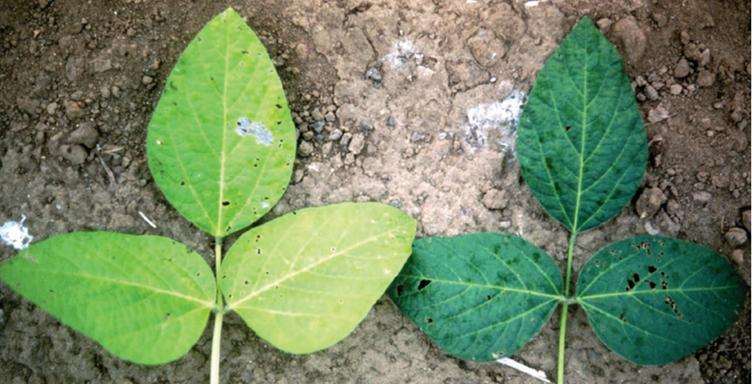Biological Nitrogen Fixation and seeding Legumes for Soil Fertility
Biological nitrogen fixation: Making soil air into nitrogen-forms plants can use
Free-living organisms in the soil can fix small amounts of Nitrogen. Sometimes large amounts can be fixed by bacteria living in symbiosis with plants supplying them with sugar and other nutrients. This is the case for legumes (=relatives of beans, peas and acacia), and for Alnus-, and Casuarina-trees. This section will include an introduction and innovative solutions to key challenges with nitrogen fixation.
Other nitrogen-fixing microorganisms can be very important in water, including wetland rice, e.g., in symbiosis with special plants:
- Duckweed fern, Azolla, infected with cyanobacteria (earlier called blue-green algae), Anabaena azollae.
- Likewise, Sesbania species are tree legumes that can grow as trees, shrubs, or green manure at wet tropical sites. (see at the background of figure 1). Nitrogen-fixing plants have many forms. Sesbania are legumes (bean familiy) species that are fast-growing, green manures and small trees. They (here Bangladesh) and grow in many parts of the tropics.

Nitrogen fixation of atmospheric N2 from the soil air can yearly make up to about 20 kg N per hectare (100 m x 100 m= 1 ha) available to plants from free-living organisms. It can be about 50-200 kg for symbiosis with at least some legumes and sites. However, biological N2-fixation requires much energy, and plants will only supply much sugar for bacteria in root nodules if it is N the plant needs most rather than other nutrients, water, or light. Plant-available phosphate and water are the most common limitation if compatible and efficient N2-fixing bacteria are available in sufficient numbers.
Some of the bacteria do not thrive at low pH (acidic soils), and root nodules demands, e.g. calcium and molybdenum, are high compared to other plant parts in the rounded structures at the surface of roots (root nodules). Unlike swellings from e.g. nematode infections or porous ventilation openings (lenticels), the nodules can easily be removed easily.
If nodules on legumes are red or pink inside, they actively fix N2 (and use legume haemoglobin). Green ones have done it. White nodules are (still) inactive. Brown nodules are rotting. Nodules less than 2 mm in diameter and round also indicate inactivity. Large, branched nodules for the species can indicate low numbers of compatible N2-fixing bacteria. The bacteria introduced to (inoculating) legumes are often from the Rhizobium genera and others in the rhizobia group of bacteria, which is much more complicated than in older books. [1]
Estimating the Most Probable Number (M.P.N.) of compatible rhizobia for the plant species’ roots in the soil is complicated, and the M.P.N. can vary much within a few meters. I found it promising to test growing legumes with surface sterilized seeds in small transparent bags and other nutrients than N added. A small amount of topsoil mixed from an area of one plant’s rootzone can be tested in each bag for its ability to effectively form nodules (nodulation) when Nitrogen is limiting growth. Testing a new legume species in several places without N2 fertilizer in a field can also be recommended – as well as checking local guidelines.
In the tropics, at least fast-growing tree legumes and soya beans often benefit from introducing (inoculation) nitrogen-fixing bacteria at new sites. One study in Africa only reported it needed for the Sesbania species, which naturally grow near wetlands also in Africa, but the soil samples were mixed from a 20 m x 20 m area (+Dr Ken Giller, personal communication, Copenhagen) and [2]. For example, in my study in western Kenya, I found such inoculation needed in one out of three soils tested for the tree legume species I studied. The species was the multipurpose tree Calliandra calothyrsus not common in the area and from central America. [3]
Research institutes or seed sellers may sell nitrogen-fixing bacteria suitable for the soil and its pH. Interestingly, a root nodule of the size of a rice grain could inoculate 10 seeds, but it was only fully effective if it was kept detached and moist for a week before crushing it into moist soil. In western Kenya, transferring topsoil alone with nodules at a rate of about 10 g per seed was fully effective, but 1 or even 0.1 g helped too [4].
Making hard legume seeds water-permeable: Scarification
Most wild (undomesticated) non-food legumes have waterproof (impermeable) hard, smooth seed coats when mature and dry. A few small pores may open after a successful hot water pre-treatment, so water is taken up over a few days or weeks. E.g., For 3 minutes in 80oC (176 oF) hot water, 5 seconds up and down from boiling water, left to cool from 60oC (140 oF) hot water works for many seeds. Some will need more, and some have sensitive germs in the tip or can be more sensitive because they are not fully dry. Guidelines often contradict each other and are unclear, so they may kill seeds or be inefficient. E.g., in practice, temperatures vary with water to seed ratio, and cooling time also depends on the size, shape, and lid of a container as well as the seed-to-water ratio. Seeds may be killed by the slow cooling of hot water in a big container. It is risky but concentrated sulphuric acid can also be used until the surface gets sufficiently visibly damaged. Rotating drums are used for seeds for some seeds (e.g., some cultivated fodder species), but shaking even a long time with sand is not enough for many tropical or tree species -despite bad guidelines.
Even a tiny cut with a knife or nail cutter can be for flat tree legume seeds, but it should not be at the pointed end with the germ and takes time. Some guidelines show it wrongly. Mechanical scar-making (mechanical or physical scarification) e.g. between extra coarse sandpaper by hand is ideal, and water uptake can be seen in seconds or minutes if done well. Mandal got excellent results with scarification between two layers of extra course sandpaper. It can be pressed with the hand, an electric sanding tool, or with a rubber shoe or sandal using the force of the leg with seeds in one layer, so they do not break. In rural Africa, for example, a rough cement floor can be used too, and sharp sand or coarse sanding paper may be added (3] [5].
At least one scratch should penetrate the shiny outer palisade layer of cells that compact when they dry irreversibly. A few species of small, multipurpose legume seeds only need to be stepped on lightly to open a hollow transparent cover. Some do not need pre-treatment (Mucuna pruriens and food legumes) and will start fermenting even after, e.g., 5-10 hours in unheated water. Testing for the ability to take up the water of fully dried, stored seeds is important, and of pre-treatments in practically relevant ways. This is often neglected, and the weather, seeds, or farmers are often blamed for failures. The author may advise relevant organizations.
Due to challenges with standard methods used by small farmers, major agroforestry organizations recommend simply soaking tree legume seeds in unheated water. It tends to work slowly, at least for some of the seeds bought not fully dry by seed centres and tested in shallow containers where seeds are picked up one by one when they take up water before they rot. Seeds can rot in water or if they are partly moist in soil but not enough to germinate.
Integrating nitrogen-fixing plants into the land-use systems
This important topic is covered more in the chapter by Mandal (2022) on soil and water conservation and in expected articles on, e.g. intercropping at Wikifarmer Library. The seed pre-treatment methods mentioned just above can help get multipurpose tree legumes to germinate when seeded (or a delay) and fit in with seeding or weeding other crops. Some ideal cover crops may be seeded at the time of the cash or food crop, then grow deep roots without harming the main crop, and later grow up when the main crop is wilting and harvested. A cover crop can help by fixing Nitrogen from soil air or by catching it from soil water (catch crop) before it is leached after a well-fertilized or -manured crop. It can also help in many other ways (building soil carbon, suppressing weeds, increasing biodiversity, microbial and animal activity, and soil conservation).
Legumes can also be pioneer trees and shrubs growing fast on open sunny land where other trees may not grow well at first. These can be used for soil and water conservation with cover near the ground, for fodder, fuel, fences, and/or any other purposes. Some species tolerate all green leaves being removed in the growing season. Some species release N fast to soil or livestock if they are high in N and low in fibres (lignin, crush between fingers when dry to test). At least in the tropics and sun-exposed tree leaves, protein-binding tannins (polyphenols) can likewise delay or reduce protein and N release. This is particularly the case if the protein surfaces can be covered much. A simple way to test and “taste” the content is to chew a plant sample and see if it makes the tongue stick a bit to the mouth like red wine. Some call fast-degrading plant manures “high quality,” but sometimes more lasting N-sources are better for crops, soils, climate, and livestock. Mixtures can also be used.
See e.g., the agroforestry article in the Soil and Water Conservation Chapter at Wikifarmer Library [6].
References:
[1] Taxonomy of rhizobia & agrobacteria – Species with standing in nomenclature Link: Taxonomy of rhizobia & agrobacteria – Species with standing in nomenclature (google.com)
[2] Bala A. Murphy P J, Osunde A O, Giller K E (2003): Nodulation of tree legumes and the ecology of their native rhizobial populations in tropical soils, Applied Soil Ecology 22, 2003, 211-223, https://doi.org/10.1016/S0929-1393(02)00157-9.
[3] Mandal, T, Nielsen, N E (2004): An improved low-input method for establishing calliandra hedgerows on small-scale farms in western Kenya. Agroforestry Systems 60, 227–231 (2004). https://doi.org/10.1023/B:AGFO.0000024414.50076.66
[4] Mandal T (2010): Low-cost soil and water conservation with many early benefits. Presentation Researchers’ Day: Climate Change Impact, Adaptation and Mitigation GEUS, Inst. of Geography, University of Copenhagen. 7 October 2010. Arranged by the Climate Change Task Force. https://www.yumpu.com/en/document/view/35209735/present-danish-water-forum
[5] Mandal, T (1994): Pre-treatment of hard coated leguminous seeds. 3 pp. In: The Fourth International Symposium – Windbreaks and Agroforestry. Hedeselskabet, Viborg, Denmark. July 26-30, 1993.
[6] Mandal T (2022): Agroforestry – combining trees and agriculture to improve Soil – Water Conservation – Wikifarmer Library
See also other Wikifarmer Library articles by Mandal (2023) and references on sustainable plant nutrient management incl. those with a focus on Nitrogen, introduction, summary, and sustainability debate.
Sustainable Plant Nutrient Management (SPNM): An overview
Sustainable Nutrient management: Introduction to concept, strategies, and principles
Nutrient conservation and cycling
Mineral fertilizers (including ash) and sustainability
Biological Nitrogen Fixation and seeding Legumes for Soil Fertility
The importance and management of Phosphorus (P) and Potassium (K) in plant production
Ion charges and secondary (=meso) nutrients: Calcium, Magnesium and Sulphur
How important are the Micronutrients for plants
Soil and plant analysis and field observations
When are approaches to Plant Nutrient Management actually Sustainable?









































































